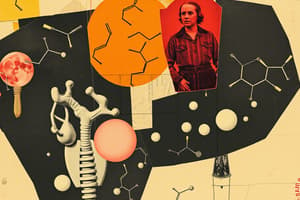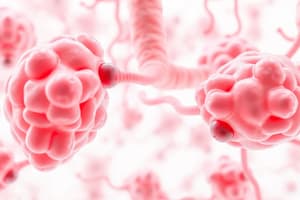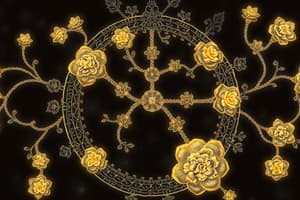Podcast
Questions and Answers
What is the precursor of all classes of steroid hormones?
What is the precursor of all classes of steroid hormones?
- Androgens
- Estrogens
- Cholesterol (correct)
- Aldosterone
Where do the synthesis and secretion of glucocorticoids and mineralocorticoids occur?
Where do the synthesis and secretion of glucocorticoids and mineralocorticoids occur?
- Adrenal cortex (correct)
- Lungs
- Ovaries and placenta
- Testes
Why do steroid hormones need to be complexed with a plasma protein for transport?
Why do steroid hormones need to be complexed with a plasma protein for transport?
- Because they are proteins
- Because they are hydrophobic (correct)
- Because they are peptides
- Because they are hydrophilic
What type of genetic diseases can be caused by deficiencies in specific steps in steroid hormone biosynthesis?
What type of genetic diseases can be caused by deficiencies in specific steps in steroid hormone biosynthesis?
What is the name of the protein that binds cortisol for transport?
What is the name of the protein that binds cortisol for transport?
Which of the following is NOT a site of synthesis and secretion of steroid hormones?
Which of the following is NOT a site of synthesis and secretion of steroid hormones?
What is the name of the class of steroid hormones that includes cortisol and aldosterone?
What is the name of the class of steroid hormones that includes cortisol and aldosterone?
What is the role of albumin in transporting steroid hormones?
What is the role of albumin in transporting steroid hormones?
What is the effect of androgens on protein metabolism?
What is the effect of androgens on protein metabolism?
What is the effect of androgens on carbohydrate metabolism?
What is the effect of androgens on carbohydrate metabolism?
What happens to bone growth in the presence of androgens?
What happens to bone growth in the presence of androgens?
What is the consequence of a defect in androgen synthesis?
What is the consequence of a defect in androgen synthesis?
What is the primary site of androgen inactivation?
What is the primary site of androgen inactivation?
What are the primary 17-ketosteroids in urine?
What are the primary 17-ketosteroids in urine?
What is the source of 17-ketosteroids in females?
What is the source of 17-ketosteroids in females?
Where are estrogens primarily produced?
Where are estrogens primarily produced?
What is the primary mechanism of action of steroid hormones?
What is the primary mechanism of action of steroid hormones?
What is the role of coactivator proteins in the mechanism of action of steroid hormones?
What is the role of coactivator proteins in the mechanism of action of steroid hormones?
Where are hormone response elements (HRE) typically found?
Where are hormone response elements (HRE) typically found?
What is the primary function of testosterone in the body?
What is the primary function of testosterone in the body?
What is the effect of androgens on the male genital system?
What is the effect of androgens on the male genital system?
What is the function of dihydrotestosterone (DHT)?
What is the function of dihydrotestosterone (DHT)?
Where are small amounts of testosterone formed in females?
Where are small amounts of testosterone formed in females?
What is the metabolic role of androgens?
What is the metabolic role of androgens?
What is the characteristic of estrone, estradiol, and estriol?
What is the characteristic of estrone, estradiol, and estriol?
Which of the following is responsible for menstrual bleeding at the end of the menstrual cycle?
Which of the following is responsible for menstrual bleeding at the end of the menstrual cycle?
What is the effect of estrogens on protein metabolism?
What is the effect of estrogens on protein metabolism?
What is the effect of estrogens on lipid metabolism?
What is the effect of estrogens on lipid metabolism?
What is the effect of estrogens on bones?
What is the effect of estrogens on bones?
How are estrogens inactivated?
How are estrogens inactivated?
What is the number of carbon atoms in estradiol?
What is the number of carbon atoms in estradiol?
Which of the following is the most potent estrogen?
Which of the following is the most potent estrogen?
What is the initial and rate-limiting reaction in steroid hormones biosynthesis?
What is the initial and rate-limiting reaction in steroid hormones biosynthesis?
What is the role of StAR protein in steroid hormones biosynthesis?
What is the role of StAR protein in steroid hormones biosynthesis?
What is the parent compound for all steroid hormones?
What is the parent compound for all steroid hormones?
What is the result of LH binding to surface receptors in the testes and ovaries?
What is the result of LH binding to surface receptors in the testes and ovaries?
What is the function of the enzyme catalyzing the initial and rate-limiting reaction in steroid hormones biosynthesis?
What is the function of the enzyme catalyzing the initial and rate-limiting reaction in steroid hormones biosynthesis?
What is required for the initial and rate-limiting reaction in steroid hormones biosynthesis?
What is required for the initial and rate-limiting reaction in steroid hormones biosynthesis?
What is the role of FSH in the regulation of sex steroid hormones synthesis?
What is the role of FSH in the regulation of sex steroid hormones synthesis?
What is the source of cholesterol substrate in steroid hormones biosynthesis?
What is the source of cholesterol substrate in steroid hormones biosynthesis?
Study Notes
Steroid Hormones Biosynthesis Overview
- Cholesterol is the precursor of all classes of steroid hormones: glucocorticoids, mineralocorticoids, and sex hormones (androgens, estrogens, and progestins).
- Synthesis and secretion occur in the adrenal cortex (cortisol, aldosterone, and androgens), ovaries and placenta (estrogens and progestins), and testes (testosterone).
- Steroid hormones are transported by the blood from their sites of synthesis to their target organs, complexed with a plasma protein.
Regulation of Steroid Hormone Synthesis
- The testes and ovaries (gonads) synthesize hormones necessary for sexual differentiation and reproduction.
- A single hypothalamic-releasing factor, gonadotropin-releasing hormone, stimulates the anterior pituitary to release the glycoproteins luteinizing hormone (LH) and follicle-stimulating hormone (FSH).
- LH stimulates the testes to produce testosterone and the ovaries to produce estrogens and progesterone.
- FSH regulates the growth of ovarian follicles and stimulates testicular spermatogenesis.
Mechanism of Action of Steroid Hormones
- Each steroid hormone diffuses across the plasma membrane of its target cell and binds to a specific cytosolic or nuclear receptor.
- The receptor-ligand complexes accumulate in the nucleus, dimerize, and bind to specific regulatory DNA sequences (hormone response elements [HRE]) in association with coactivator proteins, thereby causing increased transcription of targeted genes.
Synthesis of Androgens (Male Sex Hormones)
- They contain 19 carbon atoms and are secreted by the Leydig cells of the testis.
- The main hormone secreted by the testis is testosterone, which acts as a prohormone and is converted in target tissues to the more active form dihydrotestosterone (DHT).
- Small amounts of testosterone are formed in females by the ovaries and adrenal cortex.
Metabolic Role of Androgens
- Both testosterone and DHT are anabolic and growth-promoting hormones.
- They stimulate the development and maintenance of normal structure and function of the male sex organs, and influence the development of male sex characters.
- They stimulate spermatogenesis, and have effects on protein metabolism, carbohydrate metabolism, and skeletal growth.
Defects in Androgens Synthesis
- A defect in the activity or amount of an enzyme in the pathway of steroid hormones synthesis can lead to a deficiency in the synthesis of hormones beyond the affected step and to an excess in the hormones or metabolites before that step.
- These disorders are known as the congenital adrenal hyperplasias (CAH), resulting in enlarged adrenals.
Inactivation of Androgens
- They are inactivated in the liver and excreted in the urine in conjugation with glucuronic acid or sulphuric acid.
- Excretory metabolites include androsterone and etiocholanolone.
Synthesis of Estrogens (Female Sex Hormones)
- Estrogens are produced by cells of developing Graffian follicles.
- They contain 18 carbon atoms and are characterized by having a phenolic ring A.
- They include estrone (E1), estradiol (E2), which is the most potent, and estriol (E3).
- Estradiol is secreted mainly by the ovaries in females and also formed by the placenta during pregnancy.
- Small amounts of estrogens are secreted by the testis and adrenal cortex in males.
Metabolic Role of Estrogens (Female Sex Hormones)
- They have effects on the female genital system, including the development of female sex organs and female sexual characters.
- They stimulate the development and growth of the female mammary duct system, and proliferation of vaginal epithelium and endometrium.
- They have effects on protein metabolism, lipid metabolism, and bone metabolism.
Inactivation of Estrogens (Female Sex Hormones)
- Estradiol is converted to the less active estrone and estriol in the liver, which are excreted in the urine in conjugation with glucuronic acid or sulphuric acid.
Synthesis of Progesterone (Female Sex Hormone)
- It contains 21 carbon atoms.
- It is produced by the ovaries and placenta, and has effects on the female genital system and reproductive cycle.
Studying That Suits You
Use AI to generate personalized quizzes and flashcards to suit your learning preferences.
Description
Explore the biosynthesis of sex steroids, including enzymes involved, regulation, disorders, and metabolic effects. Ideal for medicine and surgery students.




